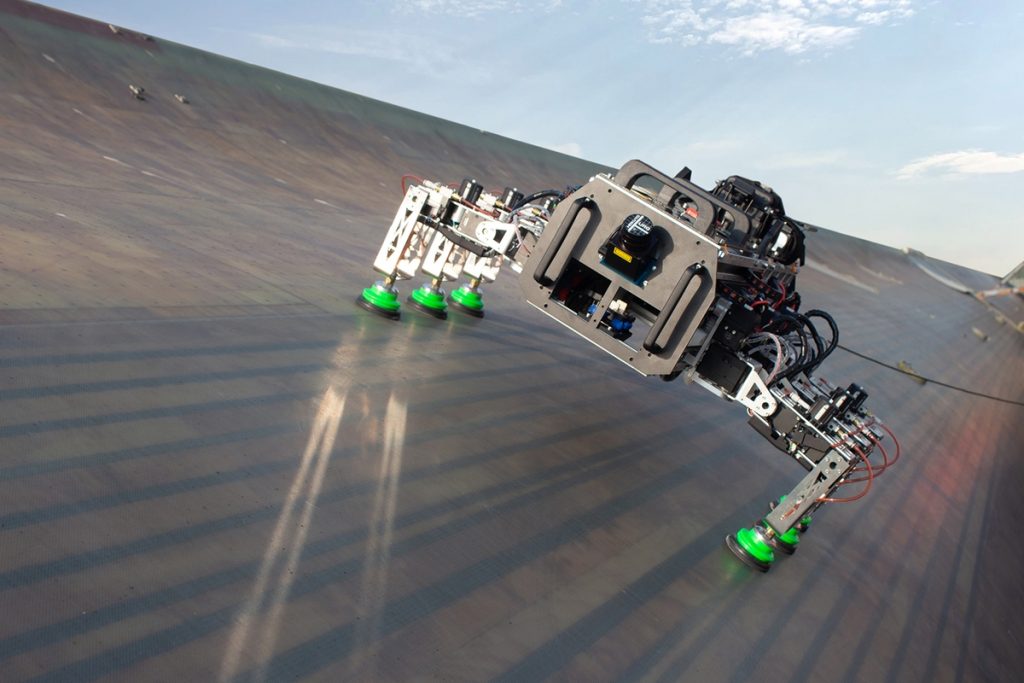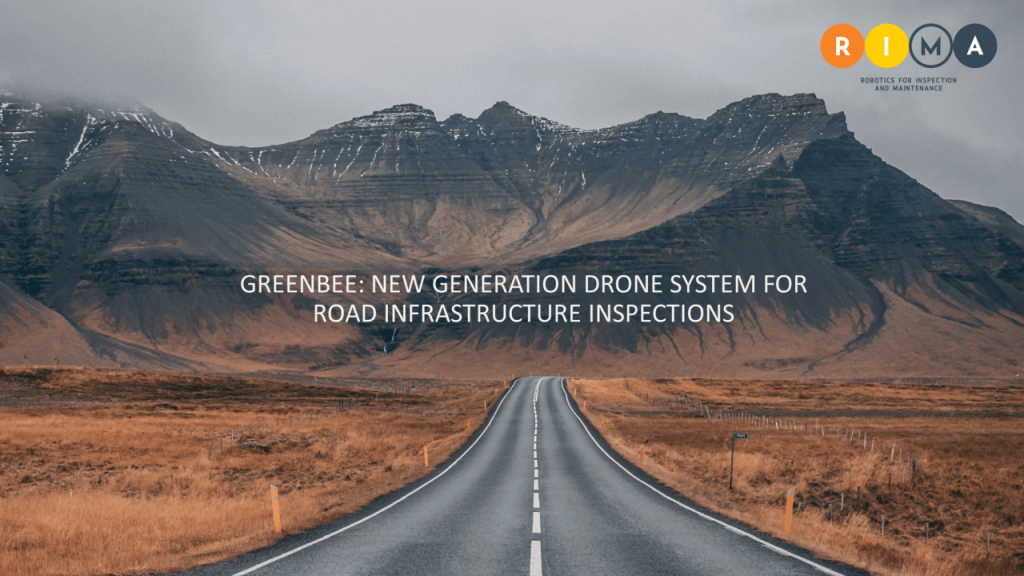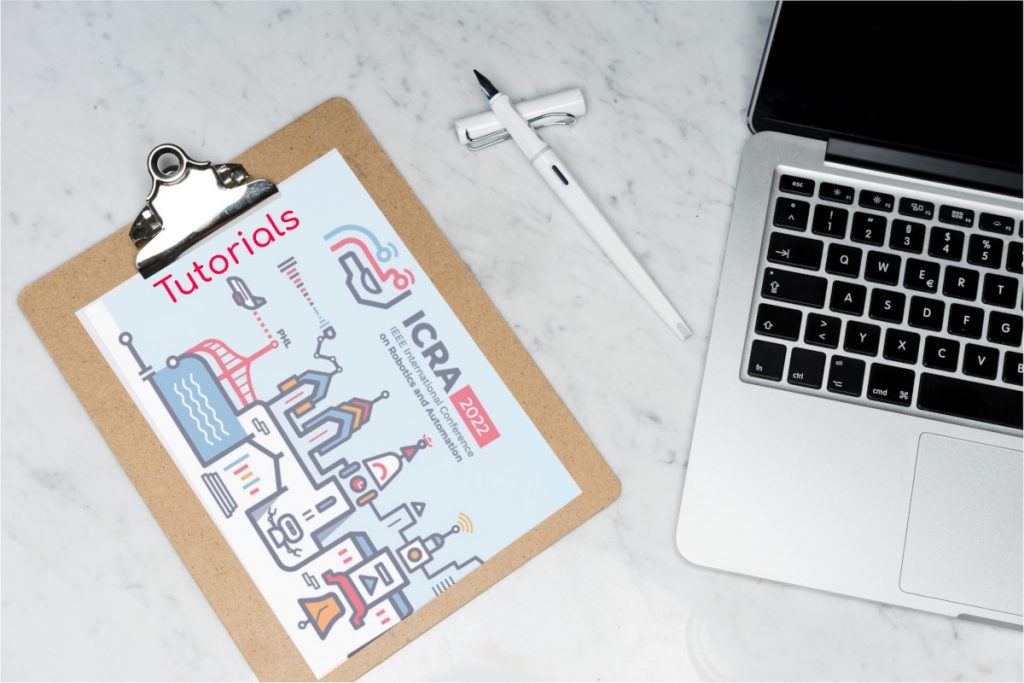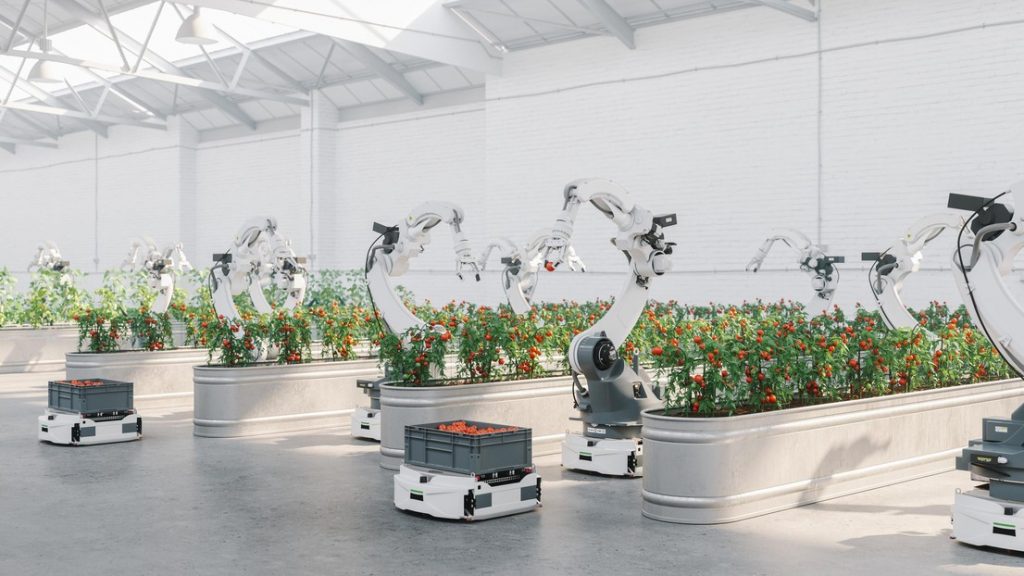A new approach to reproduce human and animal movements in robots
The Importance of Investment in Robotic Automation
Rapid adaptation of deep learning teaches drones to survive any weather
Drone swarms can now fly autonomously through thick forest
RIMA, the European robotics network for Inspection and Maintenance

Project BladeBug. Photo credits: RIMA Network
The Inspection and Maintenance (I&M) Industry represents a large economic activity spanning across multiple sectors such as energy, oil & gas, water supply, transport, civil engineering, and infrastructure. RIMA project aims at bringing together Digital Innovation Hubs and Facilitators operating under a common network that allow them to join forces and competences in promoting I&M robotics in Europe.
The BIS Research projects’ analysis of the Inspection and Maintenance Robot Industry forecasts that the I&M market will grow at a significant CAGR of 12.73% on the basis of value from 2020 to 2025. In 2019, Europe dominated the 40% of the global inspection and maintenance robot market (BIS322A, Mar 2020). Although the European Union hosts most of the I&M robotics offer – being France, Germany, and Spain (and U.K. until 2021 Brexit) the leading manufacturing countries, there is still a bottleneck connecting this offer to the market and high potential applications. Therefore, it is the aim of RIMA Network to bridge that gap and improve the connection between key stakeholders.
The RIMA Network
RIMA (Robotics for Inspection and MAintenance) started in 2019 as a European Union’s Horizon2020 initiative for bringing together Digital Innovation Hubs (DIHs) and Facilitators operating under a common network to join forces and competences in promoting I&M robotics. The project consortium consists of 23 partners including Universities, Industry associations and research institutes.
The RIMA project received € 16 Million for establishing a network of Digital Innovation Hubs (DIH) and industry associations to support the uptake of robotics – and help European small and medium-sized companies (SMEs) to develop novel solutions for different industry sectors.
The Digital Innovation Hubs offer key acceleration services for companies. Linked to organisations involved in research and innovation activities, they offer expertise in robotics, equipment, and services applicable for, in this case, I&M operations. The Facilitator organisations have the connections and network to reach a broad set of industries in their domains of expertise.
The RIMA Network consists of 13 Digital Innovation Hubs (DIH) with a vast experience in the field of robotics and is now accepting new DIHs with the purpose to expand the network. All the information and contact points are available on the RIMA Network community platform.
Training courses
The RIMA training framework focuses on increasing the use of digital skills and knowledge of robotics within the I&M domain, amongst a wide range of people – from students, through the current workforce or managers who need to understand the importance and effect of digitisation, and start-up technology development companies that need specific information and support for getting their technology to market.
RIMA offers special trainings on the field of I&M in topics such as financing, current and upcoming robotics technologies, optimisation, innovation management, and working with robots or with virtual reality (VR) and simulation.
Information on existing and future training courses is accessible in the RIMA community and soon in the RIMA YouTube Channel.
Cross-border experiments
RIMA has supported financially and technically 50 cross-border experiments involving European Small and Medium-sized enterprises through two Open Call rounds – the first one in 2019 and the second one in 2020 – with a total amount of 8.1M€.
The successful candidates have received equity-free funding for Technology transfer and development in I&M robotic applications. We will present in future articles some examples of success stories funded through RIMA such as INOWATT, Pipeye RIE, TANGO, ROBUCLEAN, RPIMUS, ACIDRONES, and RAHIP. Stay tuned!

Project GreenBee. Photo credits: RIMA Network
RIMA Network at the European Robotics Forum 2022
The European Robotics Forum (ERF) is one of the most influential events for the robotics and artificial intelligence community in Europe. This year the event takes place from the 28th to the 30th of June in Rotterdam, The Netherlands.
In the session of the 29th of June, “DIH as driver for innovative experimentation: The RIMA Network case”, the RIMA project will offer a holistic approach on the field of DIH-supported experimentation in robotics to allow the audience to gather best practices, inspiration, robotic at I&M literacy, connection with the EU DIH Network, and value propositions to incorporate to their service catalogue.
More information can be found on the ERF2022 website or you can contact RIMA’s Communication lead Juan Antonio Pavón Losada.
Join the RIMA Network community
The RIMA Network offers a global online community that brings together technology providers, service providers, asset owners and operators, with Digital Innovation Hubs and Facilitators. The RIMA Network community platform is a place to collaborate, share information on I&M robotics and keep up to date on RIMA activities. You can join the RIMA community for free here.
RIMA, the European robotics network for Inspection and Maintenance

Project BladeBug. Photo credits: RIMA Network
The Inspection and Maintenance (I&M) Industry represents a large economic activity spanning across multiple sectors such as energy, oil & gas, water supply, transport, civil engineering, and infrastructure. RIMA project aims at bringing together Digital Innovation Hubs and Facilitators operating under a common network that allow them to join forces and competences in promoting I&M robotics in Europe.
The BIS Research projects’ analysis of the Inspection and Maintenance Robot Industry forecasts that the I&M market will grow at a significant CAGR of 12.73% on the basis of value from 2020 to 2025. In 2019, Europe dominated the 40% of the global inspection and maintenance robot market (BIS322A, Mar 2020). Although the European Union hosts most of the I&M robotics offer – being France, Germany, and Spain (and U.K. until 2021 Brexit) the leading manufacturing countries, there is still a bottleneck connecting this offer to the market and high potential applications. Therefore, it is the aim of RIMA Network to bridge that gap and improve the connection between key stakeholders.
The RIMA Network
RIMA (Robotics for Inspection and MAintenance) started in 2019 as a European Union’s Horizon2020 initiative for bringing together Digital Innovation Hubs (DIHs) and Facilitators operating under a common network to join forces and competences in promoting I&M robotics. The project consortium consists of 23 partners including Universities, Industry associations and research institutes.
The RIMA project received € 16 Million for establishing a network of Digital Innovation Hubs (DIH) and industry associations to support the uptake of robotics – and help European small and medium-sized companies (SMEs) to develop novel solutions for different industry sectors.
The Digital Innovation Hubs offer key acceleration services for companies. Linked to organisations involved in research and innovation activities, they offer expertise in robotics, equipment, and services applicable for, in this case, I&M operations. The Facilitator organisations have the connections and network to reach a broad set of industries in their domains of expertise.
The RIMA Network consists of 13 Digital Innovation Hubs (DIH) with a vast experience in the field of robotics and is now accepting new DIHs with the purpose to expand the network. All the information and contact points are available on the RIMA Network community platform.
Training courses
The RIMA training framework focuses on increasing the use of digital skills and knowledge of robotics within the I&M domain, amongst a wide range of people – from students, through the current workforce or managers who need to understand the importance and effect of digitisation, and start-up technology development companies that need specific information and support for getting their technology to market.
RIMA offers special trainings on the field of I&M in topics such as financing, current and upcoming robotics technologies, optimisation, innovation management, and working with robots or with virtual reality (VR) and simulation.
Information on existing and future training courses is accessible in the RIMA community and soon in the RIMA YouTube Channel.
Cross-border experiments
RIMA has supported financially and technically 50 cross-border experiments involving European Small and Medium-sized enterprises through two Open Call rounds – the first one in 2019 and the second one in 2020 – with a total amount of 8.1M€.
The successful candidates have received equity-free funding for Technology transfer and development in I&M robotic applications. We will present in future articles some examples of success stories funded through RIMA such as INOWATT, Pipeye RIE, TANGO, ROBUCLEAN, RPIMUS, ACIDRONES, and RAHIP. Stay tuned!

Project GreenBee. Photo credits: RIMA Network
RIMA Network at the European Robotics Forum 2022
The European Robotics Forum (ERF) is one of the most influential events for the robotics and artificial intelligence community in Europe. This year the event takes place from the 28th to the 30th of June in Rotterdam, The Netherlands.
In the session of the 29th of June, “DIH as driver for innovative experimentation: The RIMA Network case”, the RIMA project will offer a holistic approach on the field of DIH-supported experimentation in robotics to allow the audience to gather best practices, inspiration, robotic at I&M literacy, connection with the EU DIH Network, and value propositions to incorporate to their service catalogue.
More information can be found on the ERF2022 website or you can contact RIMA’s Communication lead Juan Antonio Pavón Losada.
Join the RIMA Network community
The RIMA Network offers a global online community that brings together technology providers, service providers, asset owners and operators, with Digital Innovation Hubs and Facilitators. The RIMA Network community platform is a place to collaborate, share information on I&M robotics and keep up to date on RIMA activities. You can join the RIMA community for free here.
Reinventing Intralogistics
Taste of the future: Robot chef learns to ‘taste’ as it goes
Artificial skin could give robots a sense of touch similar to humans
Soft assistive robotic wearables get a boost from rapid design tool
What’s the Difference Between AGVs and AMRs?
Automation for All
A newcomer’s guide to #ICRA2022: Tutorials

I believe that one of the best ways to get the training you need for a job market in robotics is to attend tutorials at conferences like ICRA. Unlike workshops where you might listen to some work-in-progress, other workshop paper presentations and panel discussions, tutorials are exactly what they sound like. They aim to give you some hands-on learning sessions on technical tools/skills with specific learning objectives.
As such, most tutorials would expect you to come prepared to actively participate and follow along. For instance, the “Tools for Robotic Reinforcement Learning” tutorial expects you to come knowing how to code in python and have basic knowledge of reinforcement learning because you’ll be expected to use those skills/knowledge in the hands-on sessions.
There are seven tutorials this year.
Those interested in the intersection of machine learning and robotics (yes, yes, robotics and AI don’t refer to the same things, even if many people think they are the same) might find the following tutorials interesting.
- Tools for Robotic Reinforcement Learning
- Data-driven revolution in autonomous driving
- Learning Motion Control for Mobile Robot Navigation – A Tutorial
For those who are more into robots that navigate around our environment, the NavAbility Tutorial Workshop on Non-Gaussian SLAM and Computation is a series of hands-on tutorials that would be highly interesting for you. Be prepared to come with your own laptop to go from getting to know non-gaussian SLAM to solve your SLAM problems.
Meanwhile, roboticists who are more hardware and design-oriented might find the Jamming in Robotics: From Fundamental Building Blocks to Robotic Applications tutorial useful. By “jamming”, they don’t mean musicians coming together to create cool music together — I only found this out through the tutorial website. It refers to the way robots can grab items without needing to have traditional, fingered grippers.
The Tutorial on Koopman Operator and Lifting Linearization: Emerging Theory and Applications of Exact Global Linearization would be interesting for anyone interested in mathy/control/theory side of robotics. Koopman operators have been the buzz in the robotics community recently, and the tutorial is sure to give you the in-depth look at what the buzz is all about.
Lastly, the How to write an R-article and benchmark your results tutorial is one to watch for. It will tell you all about publishing reproducibility-friendly articles, and emphasize the usefulness of doing research in reproducible ways.
How to compete with robots

When it comes to the future of intelligent robots, the first question people ask is often: how many jobs will they make disappear? Whatever the answer, the second question is likely to be: how can I make sure that my job is not among them?
In a study just published in Science Robotics, a team of roboticists from EPFL and economists from the University of Lausanne offers answers to both questions. By combining the scientific and technical literature on robotic abilities with employment and wage statistics, they have developed a method to calculate which of the currently existing jobs are more at risk of being performed by machines in the near future. Additionally, they have devised a method for suggesting career transitions to jobs that are less at risk and require smallest retraining efforts.
“There are several studies predicting how many jobs will be automated by robots, but they all focus on software robots, such as speech and image recognition, financial robo-advisers, chatbots, and so forth. Furthermore, those predictions wildly oscillate depending on how job requirements and software abilities are assessed. Here, we consider not only artificial intelligence software, but also real intelligent robots that perform physical work and we developed a method for a systematic comparison of human and robotic abilities used in hundreds of jobs”, says Prof. Dario Floreano, Director of EPFL’s Laboratory of Intelligent Systems, who led the study at EPFL.
The key innovation of the study is a new mapping of robot capabilities onto job requirements. The team looked into the European H2020 Robotic Multi-Annual Roadmap (MAR), a strategy document by the European Commission that is periodically revised by robotics experts. The MAR describes dozens of abilities that are required from current robot or may be required by future ones, ranging, organised in categories such as manipulation, perception, sensing, interaction with humans. The researchers went through research papers, patents, and description of robotic products to assess the maturity level of robotic abilities, using a well-known scale for measuring the level of technology development, “technology readiness level” (TRL).
For human abilities, they relied on the O*net database, a widely-used resource database on the US job market, that classifies approximately 1,000 occupations and breaks down the skills and knowledge that are most crucial for each of them
After selectively matching the human abilities from O*net list to robotic abilities from the MAR document, the team could calculate how likely each existing job occupation is to be performed by a robot. Say, for example, that a job requires a human to work at millimetre-level precision of movements. Robots are very good at that, and the TRL of the corresponding ability is thus the highest. If a job requires enough such skills, it will be more likely to be automated than one that requires abilities such as critical thinking or creativity.
The result is a ranking of the 1,000 jobs, with “Physicists” being the ones who have the lowest risk of being replaced by a machine, and “Slaughterers and Meat Packers”, who face the highest risk. In general, jobs in food processing, building and maintenance, construction and extraction appear to have the highest risk.
“The key challenge for society today is how to become resilient against automation” says Prof. Rafael Lalive. who co-led the study at the University of Lausanne. “Our work provides detailed career advice for workers who face high risks of automation, which allows them to take on more secure jobs while re-using many of the skills acquired on the old job. Through this advice, governments can support society in becoming more resilient against automation.”
The authors then created a method to find, for any given job, alternative jobs that have a significantly lower automation risk and are reasonably close to the original one in terms of the abilities and knowledge they require – thus keeping the retraining effort minimal and making the career transition feasible. To test how that method would perform in real life, they used data from the US workforce and simulated thousands of career moves based on the algorithm’s suggestions, finding that it would indeed allow workers in the occupations with the highest risk to shift towards medium-risk occupations, while undergoing a relatively low retraining effort.
The method could be used by governments to measure how many workers could face automation risks and adjust retraining policies, by companies to assess the costs of increasing automation, by robotics manufacturers to better tailor their products to the market needs; and by the public to identify the easiest route to reposition themselves on the job market.
Finally, the authors translated the new methods and data into an algorithm that predicts the risk of automation for hundreds of jobs and suggests resilient career transitions at minimal retraining effort, publicly accessible at http://lis2.epfl.ch/resiliencetorobots.
This research was funded by the CROSS (Collaborative Research on Science and Society) Program in EPFL’s College of Humanities; by the Enterprise for Society Center at EPFL; as a part of NCCR Robotics, a National Centres of Competence in Research, funded by the Swiss National Science Foundation (SNSF grant number 51NF40_185543); by the European Commission through the Horizon 2020 projects AERIAL-CORE (grant agreement no. 871479) and MERGING (grant agreement no. 869963); and by SNSF grant no. 100018_178878.